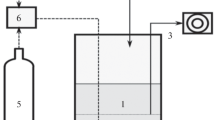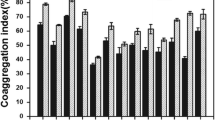Abstract
Using a successive transfer method on mineral salt medium containing simazine, a microbial community enriched with microorganisms able to grow on simazine was obtained. Afterwards, using a continuous enrichment culture procedure, a bacterial community able to degrade simazine from an herbicide formulation was isolated from a chemostat. The continuous selector, fed with a mineral salt medium containing simazine and adjuvants present in the commercial herbicide formulation, was maintained in operation for 42 days. Following the lapse of this time, the cell count increased from 5 × 105 to 3 × 108 CFU mL−1, and the simazine removal efficiency reached 96%. The chemostat’s bacterial diversity was periodically evaluated by extracting the culture’s bacterial DNA, amplifying their 16S rDNA fragments and analyzing them by thermal gradient gel electrophoresis. Finally, a stable bacterial consortium able to degrade simazine was selected. By PCR amplification, sequencing of bacterial 16S rDNA amplicons, and comparison with known sequences of 16S rDNA from the NCBI GenBank, eight bacterial strains were identified. The genera, Ochrobactrum, Mycobacterium, Cellulomonas, Arthrobacter, Microbacterium, Rhizobium and Pseudomonas have been reported as common degraders of triazinic herbicides. On the contrary, we were unable to find reports about the ability of the genus Pseudonocardia to degrade triazinic compounds. The selected bacterial community was attached to a porous support in a concurrently aerated four-stage packed-bed reactor fed with the herbicide. Highest overall simazine removal efficiencies η SZ were obtained at overall dilution rates D below 0.284 h−1. However, the multistage packed bed reactor could be operated at dilution rates as high as D = 3.58 h−1 with overall simazine removal volumetric rates R v,SZ = 19.6 mg L−1 h−1, and overall simazine removal specific rates R X,SZ = 13.48 mg (mg cell protein)−1 h−1. Finally, the consortium’s ability to degrade 2-chloro-4,6-diamino-1,3,5-triazine (CAAT), cyanuric acid and the herbicide atrazine, pure or mixed with simazine, was evaluated in fed batch processes.








Similar content being viewed by others
References
Adams CD, Randtke SJ (1992) Ozonation byproducts of atrazine in synthetic and natural waters. Environ Sci Technol 26:2218–2227
Albrecht K, Frisch G (1989) Liquid pesticidal compositions in the form of suspension concentrates. US Patent 4,804,399
Albrecht K, Frisch G (1992) Liquid herbicidal mixed formulations. US Patent 5,152,823
Balbus J (2002) Water quality and water resources. In: Michell M (ed) Life support. The environment and human health. MIT Press, USA
Baranowska I, Barchanska H, Pyrsz A (2005) Distribution of pesticides and heavy metals in trophic chain. Chemosphere 60(11):1590–1599
Chung KH, Ro KS, Roy D (1996) Fate and enhancement of atrazine biotransformation in anaerobic wetland sediment. Water Res 30(2):341–346
De Souza LM, Sadowsky JM, Wackett LP (1996) Atrazine chlorohydrolase from Pseudomonas sp. strain ADP: gene sequence, enzyme purification and protein characterization. J Bacteriol 178(16):4894–4900
Dombek T, Davis D, Stine J, Klarup D (2004) Degradation of terbutylazine (2-chloro-4-ethylamino-6-terbutylamino-1,3,5-triazine), deisopropyl atrazine (2-amino-4-chloro-6-ethylamino-1,3,5-triazine), and chlorinated dimethoxy triazine (2-chloro-4,6-dimethoxy-1,3,5-triazine) by zero valent iron and electrochemical reduction. Environ Pollut 129(2):267–275
Eichner CA, Erb RW, Timmis KN, Wagner-Döbler I (1999) Thermal gradient gel electrophoresis analysis of bioprotection from pollutant shocks in the activated sludge microbial community. Appl Environ Microbiol 65(1):102–109
Eke KR, Barnden AD, Tester DJ (1996) Impact of agricultural pesticides on water quality. In: Hester RE, Harrison RM (eds) Agricultural chemicals and the environment. Issues in environmental science and technology, vol 5. The Royal Society of Chemistry, UK
Farré MJ, Franch MI, Malato S, Ayllón JA, Peral J, Doménech X (2005) Degradation of some biorecalcitrant pesticides by homogeneous and heterogeneous photocatalytic ozonation. Chemosphere 58(8):1127–1133
Feakin SJ, Blackburn E, Burns RG (1995) Inoculation of granular activated carbon in a fixed bed with s-triazine-degrading bacteria as a water treatment process. Water Res 29(3):819–825
Felske A, Engelen B, Nübel U, Backhaus H (1996) Direct ribosome isolation from soil to extract bacterial rRNA for community analysis. Appl Environ Microbiol 62:4162–4167
Fragoeiro S, Magan S (2005) Enzymatic activity, osmotic stress and degradation of pesticide mixtures in soil extract liquid broth inoculated with Phanerochaete chrysosporium and Trametes versicolor. Environ Microbiol 7(3):348–355
Gonzalez-Barreiro O, Rioboo C, Herrero C, Cid A (2006) Removal of triazine herbicides from freshwater systems using photosynthetic microorganisms. Environ Pollut 144(1):266–271
Grigg BC, Bianchi CL, Pirola C, Ragaini V, Selli E. (2006) Mechanism and efficiency of atrazine degradation under combined oxidation processes. Appl Catal B Environ 64(1–2):31–138
Grigg BC, Bischoff M, Turco RF (1997) Cocontaminant effects on degradation of triazine herbicides by a mixed microbial culture. J Agric Food Chem 45(3):995–1000
Gunasekara AS, Troiano J, Goh KS Tjeerdema RS (2007) Chemistry and fate of simazine. Rev Environ Contam Toxicol 189:1–23
Hong C, Shimomura-Shimizu M, Muroi M, Tanamoto K (2004) Effect of endocrine disrupting chemicals on lipopolysaccharide-induced tumor necrosis factor-ALPHA- and nitric oxide production by mouse macrophages. Biol Pharm Bull 27(7):1136–1139
Igarashi A, Ohtsu S, Muroi M, Tanamoto K (2006) Effects of possible endocrine disrupting chemicals on bacterial component-induced activation of NF-κB. Biol Pharm Bull 29(10):2120–2122
Ioannis K, Theophanis S, Vasileios S, Albanis TA (2001) Photocatalytic Degradation of selected S-triazine herbicides and organophosphorus insecticides over aqueous TiO2 suspensions. Environ Sci Technol 35(2):398–405
Jiang H, Adams C (2006) Treatability of chloro-s-triazines by conventional drinking water treatment technologies. Water Res 40(6):1657–1667
Kilroy KC, Watkins SA (1997) Pesticides in surface water, bottom sediment, crayfish, and shallow ground water in Las Vegas Valley area, Carson River Basin, and Truckee River Basin, Nevada and California, 1992–1995, US Geological Survey Fact Sheet FS-075–97
Kodama T, Ding L, Yoshida M, Yajima M (2001) Biodegradation of an s-triazine herbicide, simazine. J Mol Catal B Enzym 11(4–6):1073–1078
Kontchou CY, Gschwind N (1999) Biodegradation of s-triazine compounds by a stable mixed bacterial community. Ecotoxicol Environ Saf 43(1):47–56
Laabs V, Wehrhan A, Pinto A, Dores E, Amelung W (2007) Pesticide fate in tropical wetlands of Brazil: An aquatic microcosm study under semi-field conditions. Chemosphere 67(5):975–989
Lai M-S, Weber AS, Jensen JN (1995) Oxidation of simazine: Biological oxidation of simazine and its chemical oxidation byproducts. Water Environ Res 67(3):347–354
Lowry OH, Rosebrough NJ, Farr AL, Randall RJ (1951) Protein measurement with the Folin-Phenol reagents. J Biol Chem 193:265–275
Ma J, Graham NJD (2000) Degradation of atrazine by manganese-catalysed ozonation: influence of radical scavengers. Water Res 34(15):3822–3828
Matamoros V, Puigagut J, García J, Bayona JM (2007) Behavior of selected priority organic pollutants in horizontal subsurface flow constructed wetlands: A preliminary screening. Chemosphere 69(9):1374–1380
Maurino V, Minero C, Pelizzetti E (1997) Heterogeneous photocatalytic transformations of s-triazine derivatives. Res Chem Intermed 23(4):291–310
Menne H, Köcher H (2007) HRAC classification of herbicides and resistance development. In: Krämer W, Schirmer U (eds) Modern crop protection compounds. Wiley-VCH, Weinheim
Meunier L, Canonica S, von Gunten U (2006) Implications of sequential use of UV and ozone for drinking water quality. Water Res 40(9):1864–1876
Minero C, Pelizzetti E, Malato S, Blanco J (1996) Large solar plant photocatalytic water decontamination: degradation of atrazine. Solar Energy 56(5):411–419
Nishimura K, Yamamoto M, Nakagomi T, Takiguchi Y, Naganuma T, Uzuka Y (2002) Biodegradation of triazine herbicides on polyvinylalcohol gel plates by the soil yeast Lipomyces starkeyi. Appl Microbiol Biotechnol 58:848–852
Norris RF (1982) Action and fate of adjuvants in plants. In: Adjuvants for Herbicides, WSSA, Champaign, IL, pp 68–83
Parr JF, Norman AG (1965) Considerations in the use of surfactants in plant systems: A review. Bot Gazz 126(2):86–96
Ralebitso KT, Senior E, van Venserfeld HW (2002) Microbial aspects of atrazine degradation in natural environments. Biodegrad 13:11–19
Relman DA (1993) Universal bacterial 16S rDNA amplification and sequencing. In: Persing HD, Smith TF, Tenover CF, White ST (eds) Diagnostic molecular microbiology. Principles and applications. American Chemical Society, Washington DC
Saez F, Pozo C, Gomez MA, Martinez-Toledo MV, Rodelas B, Gonzalez-Lopez J (2006) Growth and denitrifying activity of Xanthobacter autotrophicus CECT 7064 in the presence of selected pesticides. Appl Microbiol Biotechnol 71(4):563–567
Sanderson JT, Letcher RJ, Heneweer M, Giesy JP, van den Berg M (2001) Effects of chloro-s-triazine herbicides and metabolites on aromatase activity in various human cell lines and on vitellogenin production in male carp hepatocytes. Environ Health Perspect 109(10):1027–1031
Satsuma K, Kameshiro M, Hayashi O, Sato K, Kato Y (2006) Characterization of a Nocardioides based, atrazine-mineralizing microbial colony isolated from Japanese riverbed sediment. J Pestic Sci 31(4):420–423
Strong CL, Rosendahl C, Johnson G, Sadowsky JM, Wacket LP (2002) Arthrobacter aurescens TC1 metabolizes diverse s-triazine ring compounds. Appl Environ Microbiol 68(12):5973–5980
U.S. Environmental Protection Agency (1996) Drinking water regulations and health advisories: US Environmental Protection Agency, Office of Water, Report EPA-822-B-96-002
Udiković-Kolić N, Hršak D, Kolar AB, Petrić I, Stipičevic S, Soulas G, Martin-Laurent F (2007) Combined metabolic activity within an atrazine-mineralizing community enriched from agrochemical factory soil. Int Biodeterior Biodegradation 60(4):299–307
Weisburg WC, Barns SM, Pelletier DA, Lane DS (1991) 16S ribosomal DNA amplification for phylogenetic study. J Bacteriol 173:697–703
Zhang J, Chiao C (2002) Novel Approaches for remediation of pesticide pollutants. Int J Environ Pollut 18(5):423–433
Acknowledgments
The authors wish to thank COFAA-IPN for fellowships to C. Juárez-Ramírez, N. Ruiz-Ordaz, E. Curiel-Quesada and J. Galíndez-Mayer, to SIP-IPN for financial support and to Conacyt for graduate scholarships to M-P, M.E. and T-G, A.
Author information
Authors and Affiliations
Corresponding author
Rights and permissions
About this article
Cite this article
Mondragón-Parada, M.E., Ruiz-Ordaz, N., Tafoya-Garnica, A. et al. Chemostat selection of a bacterial community able to degrade s-triazinic compounds: continuous simazine biodegradation in a multi-stage packed bed biofilm reactor. J Ind Microbiol Biotechnol 35, 767–776 (2008). https://doi.org/10.1007/s10295-008-0347-4
Received:
Revised:
Accepted:
Published:
Issue Date:
DOI: https://doi.org/10.1007/s10295-008-0347-4




